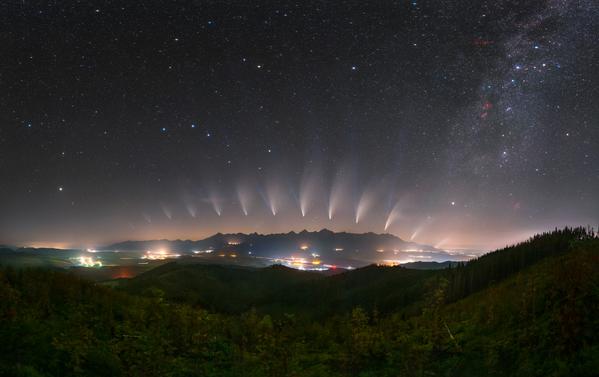This page describes an image La metamorfosi di Neowise, di Tomáš Slovinský e Petr Horalek, Slovacchia
Image caption:
Primo posto al concorso di astrofotografia IAU OAE 2021, categoria Comete.
Questa immagine utilizza la tecnica della cronofotografia per catturare l'evoluzione della cometa C/2020 F3 (Neowise) nel tempo, quando è diventata visibile nei cieli settentrionali nel luglio 2020. Le orbite delle comete sono estremamente ellittiche, il che significa che durante una parte della loro orbita si avvicinano al Sole. Quando una cometa si avvicina al Sole, si riscalda e rilascia gas e polvere creando un involucro o chioma intorno al nucleo. Il vento solare e i fotoni (particelle di radiazione elettromagnetica) interagiscono con la chioma producendo la coda cometaria, chiaramente visibile in questa immagine. La coda di una cometa punta sempre lontano dal Sole e si estende fino a decine di milioni di chilometri. Questa coda è composta da due parti: la coda relativamente diritta di gas bluastro (ioni o plasma), che è costituita da particelle cariche che interagiscono con i campi magnetici del vento solare; la coda biancastra di polvere, composta da particelle di polvere molto piccole che sono spinte dalla pressione delle radiazioni del Sole in una forma curvata a causa della loro velocità ridotta. Due regioni del Sistema solare sono spesso associate a "magazzini" di comete: la Fascia di Kuiper e la Nube di Oort. Le comete con periodi fino a circa duecento anni provengono dalla Fascia di Kuiper, un serbatoio di materiale cometario a forma di disco situato oltre Nettuno. Le comete con periodi più lunghi provengono dalla Nube di Oort, un altro enorme serbatoio di oggetti ghiacciati, di forma sferica, che circonda il Sistema solare. Il limite esterno della nube di Oort non è ancora noto, ma potrebbe essere pari a 10 mila volte la distanza Sole-Terra, o anche di più. A causa di perturbazioni gravitazionali, alcuni di questi nuclei cometari potrebbero essere espulsi verso le regioni interne del Sistema solare, talvolta avvicinandosi alla Terra, offrendo alcune delle viste più spettacolari di un corpo celeste. L'immagine mostra anche alcune costellazioni e asterismi di rilievo come il Grande e il Piccolo Carro e la stella Polare.
Scroll to captions in other languages
Image credit:
Tomáš Slovinský e Petr Horálek/IAU OAE
Stato di traduzione della didascalia: Approvato da un revisore
traduttori della didascalia: Giuliana Giobbi, Francesco Salvestrini
revisori della didascalia: Rosa Valiante, Rodolfo Canestrari, Raffaella Ferretti
DOI: 10.5281/zenodo.5290117
Termini di glossario connessi:
Cometa
Categorie:
Astronomia ad occhio nudo
, Sistema solare
Image license: Creative Commons Attribuzione 4.0 Internazionale (CC BY 4.0) Creative Commons Attribuzione 4.0 Internazionale (CC BY 4.0) icone
If you notice a factual error in this caption or an error in any of its translations then please get in touch.
Didascalie in lingue diverse:
Image caption: First place in the 2021 IAU OAE Astrophotography Contest, category Comets.
This image uses the chronophotography technique to capture the evolution of the comet C/2020 F3 (Neowise) over time, as it became visible in the northern skies in July 2020. Orbits of comets are extremely elliptical, which means that during part of their orbit they get close to the Sun. As a comet approaches the Sun, it gets heated, releases gas and dust creating an envelope or coma around the nucleus. The solar wind and photons (particles of electromagnetic radiation) interact with the coma producing the cometary tail, which can be seen clearly in this image. The tail of a comet always points away from the Sun, and extends as much as tens of millions of kilometres. This tail has two parts: the relatively straight bluish gas (ion or plasma) tail, which is made up of charged particles interacting with the magnetic fields of the solar wind; and the whitish dust tail compose of very small dust particles that are pushed by the radiation pressure from the Sun into a curve due to their slower speeds. Two regions in the Solar System are often associated with being “storehouses” of comets: the Kuiper Belt and the Oort Cloud. Comets with periods up to about two hundred years come from the Kuiper belt, a reservoir of cometary nuclei material with a disk-like shape located beyond Neptune. Longer period comets come from the Oort cloud, another huge reservoir of icy objects, with a spherical shape surrounding the Solar System. The outer limit of the Oort Cloud is not known as yet, but it could be as much as 10 thousand times the Sun-Earth distance, or even more. Due to gravitational disturbances, some of these cometary nuclei might be ejected towards the inner regions of the Solar System, sometimes approaching the Earth, offering some of the most spectacular views of a celestial body. The image also shows some prominent constellations and asterisms like the Big and Little Dippers, and also the North (Pole) Star – Polaris.
Image credit: Tomáš Slovinský and Petr Horálek/IAU OAE
Termini di glossario connessi: Comet
Image caption: 2021年国际天文学联合会(IAU)OAE天文摄影比赛彗星类别第一名。
这幅照片使用了计时摄影技术,捕捉了 C/2020 F3(Neowise,译名“新智”)彗星随时间演变的过程,它于2020年7月出现在北半球的天空。彗星的轨道形状是极扁的椭圆,这意味着它们的一部分轨道会接近太阳。当彗星接近太阳时,它会受热并释放出气体和尘埃,围绕在彗核周围,称为彗发。太阳风和光子(构成电磁辐射的粒子)与彗发相互作用,产生彗尾,在这张图片中清晰可见。彗尾总是指向远离太阳的方向,绵延数千万公里。彗尾由两部分组成:相对笔直的蓝色气体(离子或等离子体)尾,由与太阳风磁场相互作用的带电粒子组成;白色尘埃尾,由非常小的尘埃颗粒组成,由于它们的速度较慢,因而被来自太阳的辐射压力推成曲线。太阳系中通常被认为是“彗星仓库”的两个区域是柯伊伯带和奥尔特云。周期短于二百年的彗星来自柯伊伯带,它是位于海王星以外的一个圆盘状的彗核物质库。周期长于二百年的彗星来自奥尔特云,它是另一个巨大的冰质天体库,呈球状环绕着太阳系。奥尔特云的外部界限目前还不清楚,但可能是日地距离的一万倍,甚至更远。由于引力扰动,其中一些彗核可能会被抛射到内太阳系,有时会接近地球,为人们展现最壮观的天象。图片还展示了一些著名的星座和星群,如北斗七星和小熊座,以及北极星。
Image credit: Tomáš Slovinský and Petr Horálek/IAU OAE
Termini di glossario connessi: 彗星 Caption translation status: Non ancora approvato da un revisore
Caption translators: Bao Lizhuo
Image caption: 2021年國際天文學聯合會(IAU)OAE天文攝影比賽彗星類別第一名。
這幅照片使用了計時攝影技術,捕捉了 C/2020 F3(Neowise,譯名“新智”)彗星隨時間演變的過程,它於2020年7月出現在北半球的天空。彗星的軌道形狀是極扁的橢圓,這意味著它們的一部分軌道會接近太陽。當彗星接近太陽時,它會受熱並釋放出氣體和塵埃,圍繞在彗核周圍,稱為彗發。太陽風和光子(構成電磁輻射的粒子)與彗髮相互作用,產生彗尾,在這張圖片中清晰可見。彗尾總是指向遠離太陽的方向,綿延數千萬公里。彗尾由兩部分組成:相對筆直的藍色氣體(離子或等離子體)尾,由與太陽風磁場相互作用的帶電粒子組成;白色塵埃尾,由非常小的塵埃顆粒組成,由於它們的速度較慢,因而被來自太陽的輻射壓力推成曲線。太陽系中通常被認為是“彗星倉庫”的兩個區域是柯伊伯帶和奧爾特雲。週期短於二百年的彗星來自柯伊伯帶,它是位於海王星以外的一個圓盤狀的彗核物質庫。週期長於二百年的彗星來自奧爾特雲,它是另一個巨大的冰質天體庫,呈球狀環繞著太陽系。奧爾特雲的外部界限目前還不清楚,但可能是日地距離的一萬倍,甚至更遠。由於引力擾動,其中一些彗核可能會被拋射到內太陽系,有時會接近地球,為人們展現最壯觀的天象。圖片還展示了一些著名的星座和星群,如北斗七星和小熊座,以及北極星。
Image credit: Tomáš Slovinský and Petr Horálek/IAU OAE
Termini di glossario connessi: 彗星 Caption translation status: Non ancora approvato da un revisore
Caption translators: An automated transliteration from the simplified Chinese translation by - Bao Lizhuo









